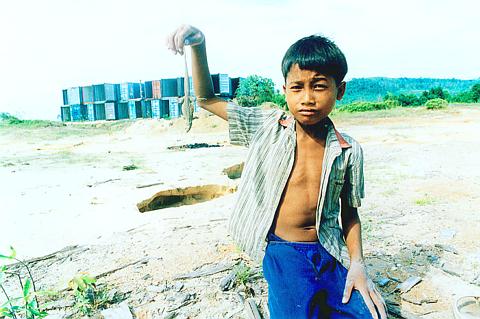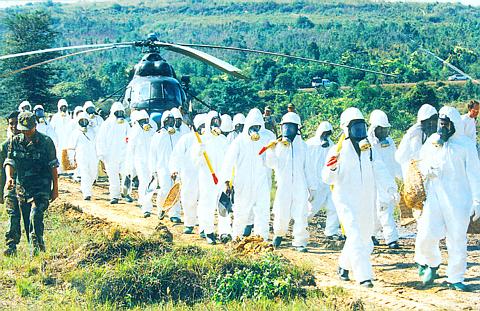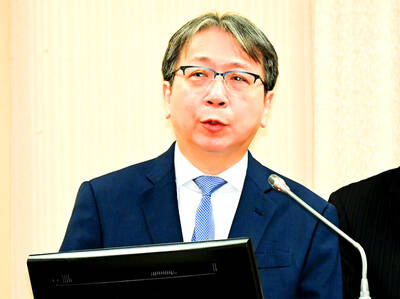About 15km outside of Sihanoukville on Cam-bodia's National Route 4, the landscape of flat farmland and scrub forest is broken by a cluster of industrial shipping containers rusting in a field of grazing cows. There are no cordons, no signposts warning of their sinister history.
The rows of 144 containers, their doors ajar in the wind or removed completely by enterprising scrap metal merchants, stand as mute memorial to what environmentalists have described as "the worst act of toxic waste dumping in recent times."
It was this patch of open ground that on Dec. 4, 1998 became the dump site for 2,900 tonnes of highly toxic waste produced in the 1980s at a Formosa Plastics Group polyvinyl chloride factory in Kaoshiung County's Jenwu township.

PHOTO: STEPHEN O'CONNELL
Although accompanying documentation from the company innocuously referred to the waste as "cement cake," subsequent testing discovered concentrations of mercury more than 20,000 times above internationally accepted safety limits, as well as dangerous levels of dioxin and polychlorinated biphenyls (PCBs).
At first the waste was just dumped in the open air as huge piles of dusty, poisoned rubble. It was only three weeks later, as a growing tide of hysteria spread across the city due to reports of death and illness connected with the waste, that it was packed into the cargo containers.
Four months after it arrived, the waste was eventually removed from Cambodia on March 30, 1999.

PHOTO: CHEA SOKUNTHEA
Yet the containers remain, undisturbed on their original site, testament to what happened -- and an uncomfortable reminder for officials who would rather make the memories all go away.
A disaster forgotten
"I don't remember anything about that matter ... it was a year ago," says Om Yen Tieng, a special advisor to Prime Minister Hun Sen, who was widely considered to have been a linchpin in negotiations with Formosa Plastics that resulted in the waste's removal. "Talking about that issue is like digging up a dead body that's already been buried."
His metaphor is perhaps tastelessly apt. Human Rights Watch claims at least seven Sihanoukville residents have died from events linked directly or indirectly to the waste dumping. Two men died with symptoms of acute mercury poisoning, four were killed in car accidents as panicking residents fled the city while another man died from injuries sustained when an angry mob attacked offices of the Sihanoukville Port.
But, rather more pertinently, many more remain today in the grip of illnesses which they say were caused by exposure to the toxic waste dump. And some even say there have been many more related deaths.
Officially, there is supposed to be little still to worry about for Sihanoukville residents; the Phnom Penh headquarters of the World Health Organization (WHO) doesn't even have records of deaths from exposure to the waste.
"I hadn't heard about any deaths.... I know that people got sick but this is the first time I've heard about deaths," said Bill Pigott, Cambodia's WHO Country Representative since May 1999. "When I came I was briefed extensively by [former WHO Country Representative] George Petersen and he didn't mention there were deaths [resulting from exposure to toxic waste]."
This comes as little reassurance, however, to non-governmental organizations who have taken a closer look at the controversy. One independent American toxicologist who has done consulting work for Legal Aid of Cambodia (LAC), a non-profit organization which provides free legal counsel for low-income Cambodians, is horrified by what he calls blas? official attitudes toward the events in Sihanoukville last year.
"It appears that everyone in a position of authority wants to downplay the potential seriousness of the problem," the toxicologist, who requested anonymity, told the Taipei Times.
Unnatural causes
Sok Poeu is certainly aware of the problem's seriousness. The 28- year-old mother of three is the widow of Pich Sovann, a port worker who died on Dec. 16 after spending two days inhaling thick clouds of mercury-laden dust while sweeping out the hold of the Chang Sun.
Sovann's death was followed three days later by the death of a 23-year-old male resident of Koki village, adjacent the dump site, who had apparently slept for several days on plastic sheeting that he had scavenged from the dump site.
Both men were cremated before Medecins San Frontiers (MSF) or WHO officials could perform autopsies, leading both organizations to classify their causes of death as "inconclusive."
Difficult enough as this is for local and international NGOs to accept, official pronouncements have hardly put a seal on the case. Residents still complain of illnesses -- and some deaths -- related to the dumpsite.
Taing Sy Lay, a Sihanoukville Port worker who was hospitalized for five days last December after falling ill during the unloading of the waste, says much of her salary is now spent on medicine she takes for constant fatigue and dizziness.
"In the hospital the doctor told me my blood showed mercury [contamination], but that it would go away" Lay recalled. "I've become so weak that I miss five or six days of work each month.... A lot of my coworkers feel the same way."
And yet, according to a February 1999 MSF study of 1,300 people exposed to the waste, Lay and her co-workers should not be sick.
MSF did conclude that 48 percent of port workers and 35 percent of residents of Bettrang Commune adjacent the dump site had illnesses "consistent with short term exposure to toxins and also consistent with the 60-day half life of mercury in the body." But it had also "found no evidence that long-term health effects could be expected by those exposed to the waste."
The MSF conclusions don't go down very well in Bettrang Commune. The community's residents were the first to swarm over the waste within hours of the dumping, oblivious to the danger. Residents prized the triple-lined plastic bags that held the waste and in some cases pieces of the waste itself.
"Some people thought that the waste was a kind of fertilizer, and brought it home for their crops," says Bettrang Commune official Long Nau. "People used the bags to store rice, or as bed sheets and window screens."
Bettrang was certainly no exemplar of good public health even before toxic waste complicated the lives of its villagers. Gastroenteritis and malaria are rife, and the raw running sores on the legs of naked children here testify to the community's poor sanitation.
But according to residents and commune officials, health conditions have taken a definitive turn for the worst following since those fateful days last December. They blame their exposure to the waste and a water supply possibly tainted by runoff from the dumpsite on the hill above them.
"Things have really changed since last year," Nau said. "People have a lot of new health problems [like] strange respiratory disorders since touching the waste."
Chhim Poeu, a teacher in Bettrang, says that many local people connect the dump site with numerous deaths over the past year. "I can count 14 strong, healthy people who've died in the past year, who shouldn't have died," Poeu said.
Prove it
As far as the Cambodian government is concerned, there is no longer any cause for residents to worry. According to Heng Nareth, Director of the Department of Pollution Control under the Ministry of the Environment, comprehensive surface and ground water testing was conducted by the WHO in recent months at eight locations in and around the former dump site. "The latest results from samples taken in October indicate all values [of mercury contamination] are still well below safe drinking water guidelines," he said.
"We don't want to say we don't believe them [villagers' accounts of long term illness], but we can't do anything without realistic information from physicians."
The waste testing has not gone unchallenged, however. "It was never, in my opinion, tested adequately to identify both the variety of toxic substances or the maximum amounts of these substances," the LAC's toxicologist explained.
"Without this pre-existing know-ledge, one cannot begin to model the ground water contamination."
International environmentalists are also skeptical. Jim Puckett, of the Seattle-based Basel Action Network, is particularly critical of the unrestricted access to the former dumping site.
Although 4,000 tons of topsoil from the site were removed as part of a clean-up by an internationally renowned hazardous waste landfill company, Safety-Kleen Services Inc, Puckett fears that Bettrang residents are still in danger. Of particular concern, he says, are those who regularly comb the site for beetles and lizards which they eat or sell in the Sihanoukville market.
"Putting plants over the site to supposedly prevent access and exposure -- even if somebody bothers to do it -- is a non-solution," Puckett said. "The area should be cordoned off and placed under guard, the ground water and soil continually tested until levels reach background level."
As of yesterday, however, not even the non-solution was being put into practice. The containers stand where they are, their doors flapping at passersby.

The US government has signed defense cooperation agreements with Japan and the Philippines to boost the deterrence capabilities of countries in the first island chain, a report by the National Security Bureau (NSB) showed. The main countries on the first island chain include the two nations and Taiwan. The bureau is to present the report at a meeting of the legislature’s Foreign Affairs and National Defense Committee tomorrow. The US military has deployed Typhon missile systems to Japan’s Yamaguchi Prefecture and Zambales province in the Philippines during their joint military exercises. It has also installed NMESIS anti-ship systems in Japan’s Okinawa

TRAGEDY STRIKES TAIPEI: The suspect died after falling off a building after he threw smoke grenades into Taipei Main Station and went on a killing spree in Zhongshan A 27-year-old suspect allegedly threw smoke grenades in Taipei Main Station and then proceeded to Zhongshan MRT Station in a random killing spree that resulted in the death of the suspect and two other civilians, and seven injured, including one in critical condition, as of press time last night. The suspect, identified as a man surnamed Chang Wen (張文), allegedly began the attack at Taipei Main Station, the Taipei Fire Department said, adding that it received a report at 5:24pm that smoke grenades had been thrown in the station. One man in his 50s was rushed to hospital after a cardiac arrest

‘WIN-WIN’: The Philippines, and central and eastern European countries are important potential drone cooperation partners, Minister of Foreign Affairs Lin Chia-lung said Minister of Foreign Affairs Lin Chia-lung (林佳龍) in an interview published yesterday confirmed that there are joint ventures between Taiwan and Poland in the drone industry. Lin made the remark in an exclusive interview with the Chinese-language Liberty Times (the Taipei Times’ sister paper). The government-backed Taiwan Excellence Drone International Business Opportunities Alliance and the Polish Chamber of Unmanned Systems on Wednesday last week signed a memorandum of understanding in Poland to develop a “non-China” supply chain for drones and work together on key technologies. Asked if Taiwan prioritized Poland among central and eastern European countries in drone collaboration, Lin

ON ALERT: Taiwan’s partners would issue warnings if China attempted to use Interpol to target Taiwanese, and the global body has mechanisms to prevent it, an official said China has stationed two to four people specializing in Taiwan affairs at its embassies in several democratic countries to monitor and harass Taiwanese, actions that the host nations would not tolerate, National Security Bureau (NSB) Director-General Tsai Ming-yen (蔡明彥) said yesterday. Tsai made the comments at a meeting of the legislature’s Foreign Affairs and National Defense Committee, which asked him and Minister of National Defense Wellington Koo (顧立雄) to report on potential conflicts in the Taiwan Strait and military preparedness. Democratic Progressive Party (DPP) Legislator Michelle Lin (林楚茵) expressed concern that Beijing has posted personnel from China’s Taiwan Affairs Office to its